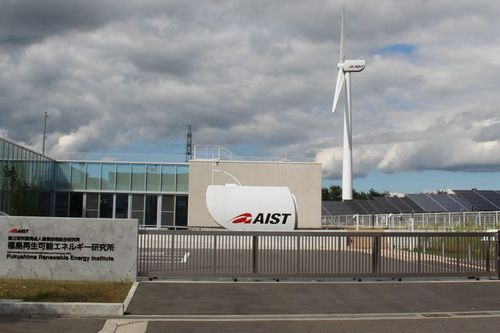March 20, 2016
Researcher Succeed in Generating Electricity Using Ammonia-Fired Gas Turbine: One Step Closer to Hydrogen Power
Keywords: Chemicals Environmental Technology

Fukushima Renewable Energy Institute
Photo by Aoi Aihara Some Rights Reserved.
Researchers recently announced that they have successfully generated 41.8 kilowatts (kW) of power using a gas turbine with ammonia as the fuel. The research was done by the Hydrogen Energy Carrier Team of the Renewable Energy Institute, part of Japan's National Institute of Advanced Industrial Science and Technology (AIST), in collaboration with the Institute of Fluid Science, Tohoku University. Below we share a report about their efforts to develop technologies capable of producing and using hydrogen at low cost, and involving no carbon dioxide emissions.
Editor's Note: This article is reproduced in edited form with permission from Smart Japan, an online media services provider specializing in energy conservation, storage, and generation.
Japan has been working toward becoming a hydrogen-based society under an initiative of the national government, along with plans to use the 2020 Tokyo Olympics and Paralympics Games to showcase these initiatives for the future of society. When considering replacing the existing energy infrastructure with hydrogen infrastructure, a vital point is figuring out how to safely store and transport hydrogen.
A "hydrogen carrier" is a medium to store and transport energy, and it takes the form a chemical substance containing large amounts of hydrogen. At present, the most promising carriers include organic hydrides, which use organic solvents for the absorption and desorption of hydrogen, and ammonia, which is synthesized from nitrogen and hydrogen and used in direct combustion.
AIST has not only been promoting the research and development of hydrogen carriers that support the large-scale introduction of renewable energy, but also working jointly with the Institute of Fluid Science at Tohoku University on the development of technology to directly burn ammonia in gas turbines to generate electricity.
Ammonia has some issues, however, such as its difficulty to ignite and slow rate of combustion compared to typical fuels. As a result, electricity generation by gas turbine using ammonia as a fuel has not been done, until now. To verify its potential as a fuel for power generation, the team conducted a demonstration test using a gas turbine that was able to run on a variety of fuels. They succeeded in generating 21 kW of electricity by combusting kerosene with an ammonia mix ratio of approximately 30 percent.
After that, with the development of the technology to operate a gas turbine using ammonia as the main fuel and the construction of facilities to supply large amounts of ammonia and methane, a demonstration test of power generation by a gas turbine using ammonia as the main fuel was reportedly conducted at the Fukushima Renewable Energy Institute, belonging to AIST.
The team then worked to improve the electricity generation equipment. It was equipped with a facility to supply stable and large flows of methane and ammonia gas, and the fuel flow control program of the gas turbine was modified so that the generator was able to operate by burning combinations of two fuels (from among kerosene, ammonia, and methane).
The gas turbine rated at 50 kW successfully generated 41.8 kW, or roughly 80% of rated output, by co-firing of methane-ammonia or by firing 100% ammonia. By adding a certain amount of ammonia to the emissions and treating them in equipment that removes nitrous oxides (NOx), the NOx concentration was reduced to 10 parts per million (ppm) or 25 ppm in 16% oxygen equivalent, which is significantly lower than the Ministry of Environment's emission standard of 70 ppm in 16% oxygen equivalent.
In a methane-ammonia combustion experiment, kerosene was first supplied to liquid fuel injection valve to start up the turbine. Once the output reached 26 kW at a stable rotating speed, methane was fed to the gaseous fuel injection valve while the kerosene injection was stopped. After shifting to methane combustion, ammonia was gradually mixed in with the methane until the methane-ammonia mass flow ratio reached the equivalent of 1:2.5 in calorific value and stable power output was obtained. Controlling the fuel injection and rotating speed, the output was then increased gradually to 41.8 kW at the rated rotation of 80,000 revolutions per minute (rpm).
In the ammonia combustion experiment, again kerosene was supplied to start the turbine, the ammonia injection was gradually increased to 100%, and the power output reached 41.8 kW at a rated rotating speed of 80,000 rpm.
These results suggest that ammonia can partially or completely replace natural gas, which is now the main fuel used in large-scale power plants in Japan, and that it could potentially serve as a hydrogen carrier and contribute to significant reductions in GHG emissions.
Although nitric oxide and other toxic gas emissions remain an issue with ammonia combustion, the resulting NOx concentrations in both experiments were successfully reduced to below 10 ppm when an adequate amount of ammonia was added to the emission gas and then processed through NOx removal equipment. The experiments conducted under the same combustion conditions also demonstrated better rates of combustion in methane-ammonia mixed combustion than 100% ammonia combustion, as the former left no unburned ammonia while the latter resulted in 11 ppm of unburned ammonia (although the latter was not detected after being treated by the NOx removal equipment).
AIST will now conduct further studies on gas turbine performance with combustion of a methane-ammonia mix and 100% ammonia in order to acquire knowledge to improve combustion rates, reduce NOx concentrations during combustion, and develop a practical ammonia-fired electricity generation system.
Source: Smart Japan (in Japanese)
Related
"JFS Newsletter"
Related
"Popular Articles"
- New Nano-Bubble Technology May Help Dissolve Sludge and Improve Water Quality
- Japanese Firm Begins Development of Tidal Power Generation System
- Small Hydropower Generation System Developed for Use in Seawater, Weight Cut by Half
- Constructed Wetland Facility Established by Japanese University Purifies Livestock Farming Drainage
- Toyota CRDL Succeeds in World's First Artificial Photosynthesis Using only Water and CO2


